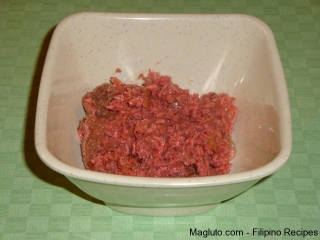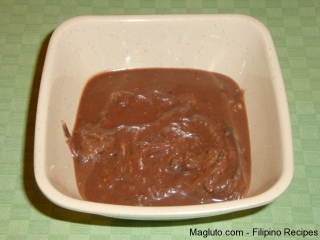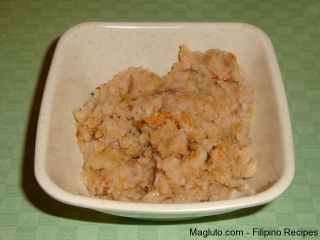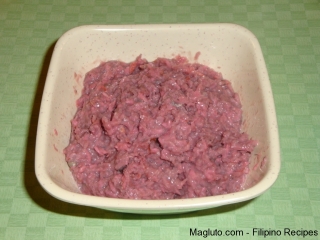Posted by denthorq on February 23, 2009, at 6:28 pm
Instructions:
4 tablespoons cooking oil
1/2 cup minced tomatoes
3 tablespoons sugar
1 tablespoon finely minced garlic
1 cup pork butt sliced into 1/4 inch pieces or less
vinegar to taste
1/2 cup finely minced onion
one 12-ounce jar of bagoong alamang or shrimp paste (sold in Oriental food stores)
How to cook:
In a skillet, heat oil and saute garlic until light brown, onion until transparent and tomatoes until soft. Stir in pork and cook until tender. Add bagoong alamang, sugar and vinegar and simmer for 10 minutes
Source: http://www.kumain.com/?p=show&id=468
Posted by denthorq on February 23, 2009, at 1:49 pm
Ingredients:
1 cup cooking oil
3 tbsp crushed garlic
1 cup chopped onions
2 long red chili peppers
1/2 cup #3 brown sugar or muscovado
1/2 cup banana catsup
1 kilo bagoong alamang
How to cook:
1. Saute garlic and onions in hot oil until limp. Add peppers, sugar, and catsup; stir until oil separates. Pour in bagoong and cook over low heat, stirring frequently to avoid scorching.
2. Simmer until reduced by 1/3 and bagoong changes color. Taste and add more sliced chili if needed.
Note: The catsup adds a hint of color to the drab bagoong, while improving its texture with the banana fruit’s natural viscosity. The tamis-anghang character of banana catsup balances the saltiness of preserved baby shrimp.
Source: http://www.mb.com.ph/issues/2009/02/08/20090208147407.html
Posted by denthorq on February 22, 2009, at 11:46 pm
Ingredients:
Use only good fresh fish (anchovies are preffered).
How to cook:
1. Wash the fish thoroughly with clean fresh water.
2. Mix the fish with clean pure salt.
( 1 part salt to 3 parts fish ) by measure
( 2 parts salt to 7 parts fish) by weight
3. Place the fish in fly proof, clean containers with a minimum.
4. Store the bagoong in a clean warm place which has a minimum of circulating air.
5. When the proper arm and body have developed in the product drain off the patis and grind the residual bagoong.
6. Strain patis and pack in clean container.
Wikipedia:
Bagoong monamon, bagoong monamon-dilis, or simply bagoong and bugguong munamon in Ilocano, is a common ingredient used in the Philippines and particularly in Northern Ilocano cuisine. It is made by fermenting salted anchovies which is not designed, nor customarily used for immediate consumption since it is completely raw. Therefore it is used as a cooking ingredient, upon when it is cooked alone, it can be used as an accompaniment to traditional food dishes. To most Westerners unfamiliar with this condiment, the smell can be extremely repulsive. Bagoong is however, an essential ingredient in many curries and sauces.
This bagoong is smoother than bagoong terong, however, they are similar in flavor. The odor is unique and smells strongly of fish. Fish sauce, common throughout Southeast Asian cuisine, is a by-product of the bagoong process. Known as patis, it is distinguished as the clear refined layer floating on the thicker bagoong, itself. Patis and bagoong can be interchanged in recipes, depending on personal taste and preference.
Bagoong is used as a flavor enhancing agent, in the place of salt, soy sauce, or monosodium glutamate. It is used fish stocks that are the base to many Ilocano dishes, like pinakbet, or as a dressing to greens as a dish called kinilnat or ensalada. Bagoong is also used as a condiment, in many cases, a dipping sauce for chicharon, green and ripe mangoes, or hard boiled eggs.
It is similar in taste and smell to that of anchovy paste.
In other areas of the Philippines, this type of bagoong can be named for the locale they came fro, eg; bagoong balayan (which is produced in the coastal town of Balayan in the Province of Batangas).
Posted by denthorq on February 22, 2009, at 11:25 pm
Ingredients:
1/2 kilo milkfish or fresh water carp (well cleaned and scaled)
2 cups cold rice, not burnt
100 grams garlic (crushed)
100 grams ginger (minced)
100 grams red onion (chopped)
6 lime wedges
pinch of salt and pepper
1/2 cup patis (fish sauce)
1/2 cup white vinegar
1/2 cup water
How to cook:
In a bowl, mix all ingredients by hand, mashing everything well.
Pour into a big mouthed bottle.
Stick fishes into the bottle.
Seal the bottle well and keep for 1-2 weeks
After 2 weeks the fish should be ready.
Source : http://www.kusinaatbp.com
Posted by denthorq on February 22, 2009, at 11:16 pm
Ingredients:
1 kilo fish (dalag or hito)
2/3 cup salt
3 1/3 cup rice
6 2/3 cup water
angkak (red rice)
Equipment:
Fermenting vessels
How to cook:
1. Preparation of the fish. Remove scales from the fish. Slice from head to tail, clean, wash and drain excess water completely. Salt and cover the fish to prevent flies from laying eggs. Allow to stand for two hours.
2. Preparation of rice. Cook the rice and cool, then blend with angkak to develop a characteristic flavor and to impart an appetite stimulating color. Pack salted fish in a mixture of salt, rice and angkak into a jar. Cover the jar with plastic bag to exclude air. Ferment for 7-10 days. Fermentation gives a pinkish color to the mixture.
3. Cooking Saute the fermented mixture with garlic and onions. Fish flesh is soft and the originally hard bones becomes tender like a cartilage after it is cooked.
Technology developed by: Industrial Technology Development Institute (DOST)
Posted by denthorq on February 22, 2009, at 11:06 pm
Ingredients:
1 mudfish (medium-sized)
1 tbsp angkak
1-cup rice
2 cups water
Salt
How to cook:
1. Clean the fish and slice into pieces. Salt all the slices and allow standing for six hours or overnight.
2. Add the water to the rice and cook. Remove the rice from the pot or pan and allow cooling.
3. Pound the angkak fine and mix with rice. Mix the fish, rice, and place in a clean glass jar with a cover.
4. Let the stand for 3 to 5 days or until the mixture smells sour.
5. To cook: Sauté chopped garlic, onion, and tomatoes in two tablespoons lard.
6. Add buro and vinegar to taste and sauté well. If the mixture is rather thick, add a little water.
7. Serve hot or cold.
Note: Angkak is a yellow coloring used for this dish.
Source: http://lutuingpilipino-blogistangpulpol.blogspot.com/2008/02/everyday-specials-burong-isda-fermented.html
Posted by denthorq on February 21, 2009, at 11:56 pm
Ingredients:
Small prawn
How to cook:
1.Mix salt with shrimp
2. The mixture is stored overnight and drained and sun dried.
3. The dried mixture is ground and packed in an earthen container.
4. The shrimp paste will sit for a few months before it is ready.
Wikipedia:
Bagoong alamang is a Filipino shrimp paste, made from minute shrimp or krill (alamang) and is commonly eaten as a topping on green mangoes or used as a major cooking ingredient. Bagoong paste varies in appearance, flavor, and spiciness depending on the type. Pink and salty bagoong alamang is marketed as “fresh”, and is essentially the shrimp-salt mixture left to marinate a few days. This bagoong is rarely used in this form, save as a topping for unripe mangoes. The paste can be sauteed with various condiments, and its flavour can range from salty to spicy-sweet. The colour of the sauce will also vary with the cooking time and the ingredients used in the sauteeing. Cincalok is the Malaysian version of ‘fresh’ bagoong alamang.
Unlike in other parts of Southeast Asia, where the shrimp are fermented beyond recognition or ground to a smooth consistency, the shrimp in bagoong alamang are readily identifiable, and the sauce itself has a chunky consistency. A small amount of cooked or sauteed bagoong is served on the side of a popular dish called “Kare-kare”, an oxtail stew made with peanuts. It is also used as the key flavouring ingredient of a sauteed pork dish, known as Binagoongan (lit. “that to which bagoong is applied”)
The word bagoong, however, is also connoted with the bonnet mouth and anchovy fish version, bagoong terong. )
Posted by denthorq on February 21, 2009, at 8:04 pm Magluto.com is a collection of delicious filipino dishes and recipes (pinoy dishes and recipes with different versions),
pinoy cooking videos, pinoy food photos and a lot more.
Our vision is to make this site a home for filipino cooking recipes and delicious filipino dishes
such as adobo, pancit, lumpia, sisig, lechon, dinuguan, sinigang etc.
Magluto.com is officially launched!
|
|



